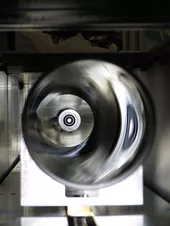Ultra-cold source (under construction)
A source of ultra-cold neutrons (UCN source) is still in the development phase, but will expand the spectrum of currently available neutrons in the future. Ultra-cold neutrons are as slow as a cyclist (<10 m / s) and can therefore be stored and observed for a long time with the help of magnetic fields or bottles of suitable materials in contrast to other neutrons. Here, the storage time in principle is only limited by the lifetime of the free neutron (about 15 min).
UCN increase the accuracy of experimentally determined fundamental metrics
The long storage times make it possible to investigate the neutron itself and its fundamental properties with high accuracy. Here, for example, attempts will be carried out to measure a possible electric dipole moment of the neutron, a property of the neutron, which could explain the imbalance of matter and antimatter in the universe. The lifetime of the free neutron is an important parameter in the standard model, which could not be determined sufficiently up to now with the available methods. Ultra-cold neutrons will also be used to test the validity of the gravitational laws at the microscopic level (at the smallest length scales in the range 10-6m).
UCN source at the FRM II
The UCN source is installed in the tangential continuous beam tube SR6. Thermal and sub-thermal neutrons from the heavy water moderator of the FRM II excite lattice vibrations in a cryo solid state body (deuterium at a temperature of 5 K) and thereby lose almost all their energy - and thus become ultra-cold neutrons. The UCN produced are extracted from the cryo solid state body and guided to the Experimental Hall to the different measuring instruments.
The UCN source is still in the construction phase, together with the various auxiliary systems that provide the necessary cooling capacity to freeze out the cryo solid state body in the immediate vicinity of the fuel element. By 2015, the necessary beam tube built-in components will be mounted and finally installed within beam tube SR6. After a commissioning phase, ultra-cold neutrons will be provided to the instruments.
